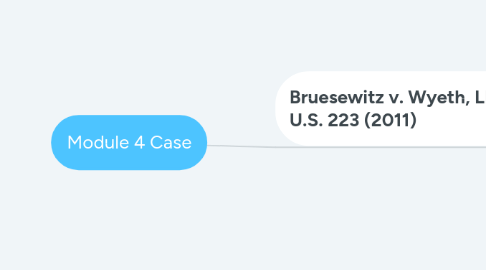
1. Bruesewitz v. Wyeth, LLC 562 U.S. 223 (2011)
1.1. Facts
1.1.1. Parties
1.1.1.1. Russel Bruesewitz and Robalee Bruesewitz
1.1.1.1.1. Hannah Bruesewitz, daughter of the petittioners
1.1.1.2. Wyeth, LLC
1.1.2. What Happened
1.1.2.1. Hannah Bruesewitz took the Tri-Immunol DTP vaccine
1.1.2.2. Two hours after taking the vaccine, Hanna Bruesewitz experienced seizures
1.1.2.3. Hannah Bruesewitz continued to experience seizures, ultimately resulting in long-term developmental problems
1.1.2.4. The Brusewitzes claimed that these were the result of taking the vaccine
1.1.3. Procedural History
1.1.3.1. The Bruesewitzes submitted case before the Vaccine Court, a special court established by the National Childhood Vaccine Injury Act (NCVIA) of 1986
1.1.3.1.1. The court found that causation was not proven
1.1.3.2. The Bruesewitzes sued in Pennsylvania state court
1.1.3.2.1. The case was removed to local federal court
1.1.3.3. Case moved to local federal court
1.1.3.3.1. The court ruled that the NCVIA preempted the claim
1.1.3.4. Appealed to the Third Circuit court of Appeals
1.1.3.4.1. Lower court decision affirmed
1.1.3.5. Case taken to US Supreme Court
1.2. Issue
1.2.1. Whether the federal NCVIA law prevents state-law design-defect claims against vaccine manufacturers
1.3. Rule of Law
1.3.1. National Childhood Vaccine Injury Act (NCVIA) of 1986
1.4. Analysis/Application
1.4.1. The NCVIA created a no-fault compensation program to stabilize the vaccine market
1.4.2. The NCVIA established a vaccine court
1.4.2.1. Vaccine court made it less costly for claimants to be compensated
1.4.3. The Act also established significant tort-liability protections
1.4.3.1. The Act eliminated vaccine manufacturer liability for unavoidable adverse side-effects
1.4.4. The Bruesewitzes claimed that Hannah had become disabled as a result of receiving a DTP vaccine
1.4.4.1. They petitioned the vaccine court, and their claim was denied
1.4.4.2. They rejected the finding, and sued in Pennsylvania court
1.4.5. The Bruesewitzes argued that the vaccine had a design defect, and was subject to liability for negligence under Pennsylvania law
1.4.5.1. The case was removed to Federal court
1.4.6. Wyeth argued that 42 U.S.C. 300aa-22(b)(1) preempted the relevant Pennsylvania law
1.4.6.1. The Federal court granted summary judgement for Wyeth.
1.4.6.2. Third Circuit court of appeals affirmed
1.4.7. The Act's intent is clearly to provide ease of relief to claimants while providing a liability shield to manufacturers
1.4.7.1. This was to create a legal environment in which consumers were not afraid of vaccines, and manufacturers were not afraid to produce vaccines
1.5. Conclusion
1.5.1. Appellate Court decision affirmed
1.6. Impact
1.6.1. Decision cited in case Holmes v. Merck & Co. Inc. 697 F.3d 1080 (2012)
1.6.2. Decision cited in case Romero v. United States of America. CIV 17-0130 JB\KBM (2018)
1.7. Importance
1.7.1. This case established that the federal NCVIA law prevents state-law design-defect claims against vaccine manufacturers
1.7.2. This case strengthened federal law's ability to supersede state law
1.8. Influence
1.8.1. This case upheld the NCVIA, which serves to strengthen the Vaccine industry
1.8.2. Without this outcome, the vaccine industry would be saddled with legal obstacles resulting from the recent largely discredited concerns over connections between vaccines and autism

